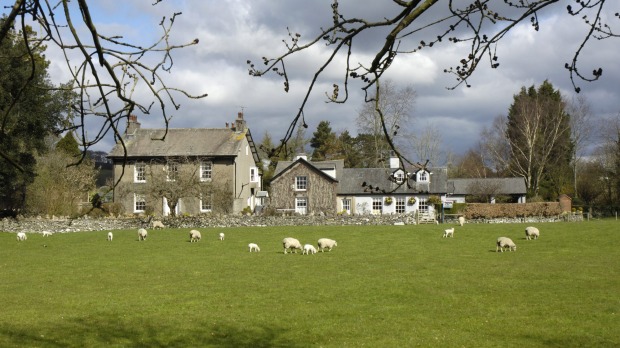
Cartmel is a bucolic village in England's Lake District which lays claim to inventing the sticky toffee pudding, that oozing nirvana of sweetness that is one of the world's favourite desserts.
More than 2000 puddings are made each week at the Cartmel Village Shop, a dear little grocery that has been named one of Rick Stein's "food heroes" and which is mecca for anyone who has a sweet tooth.
But in recent years, Cartmel has become a foodie mecca for an entirely different reason. It's the home of Britain's most acclaimed restaurant, L'Énclume, for these past two years in a row named Best Restaurant in the UK's Good Food Guide, beating Heston Blumenthal's The Fat Duck and Restaurant Gordon Ramsay.
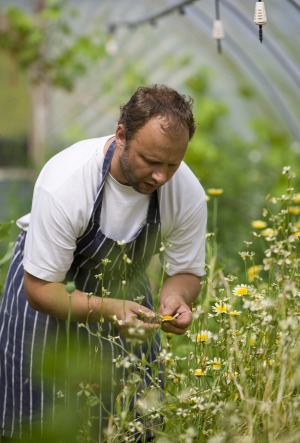
The medieval Cumbrian village has long been a tourist destination for its ancient Priory, which escaped Henry XVIII's monastery-wrecking binge, and the architecture of its streets, including the oldest standing archway in the UK. It has a grassy racecourse, a cricket field where the players wear cream flannels and a streetscape of tearooms, historic pubs and craft shops. It's as quaint as a village gets without veering into kitsch.
In 2003, innovative chef Simon Rogan, who trained with Marco Pierre White, first opened the doors of L'Énclume in a converted 800-year-old blacksmith's workshop. ('L'énclume' is French for 'the anvil'). Since then, Rogan (with business and life partner Penny Tapsell) has done what amounts to a takeover of the town, opening a second, more casual restaurant, Rogan & Co, and more recently Aulis, an experimental chef's table for six, which is housed in an ancient stone building that was the village's post office in its last incarnation. With the addition of the revamped pub, Pig 'n Whistle, Cartmel really is "Roganville".
L'Énclume now has 17 furnished rooms to meet the demand from diners from out of town who wish for somewhere handy to stay. A starring role in the Steve Coogan/Rob Brydon comedy The Trip hasn't hurt its popularity - the Saturday night waiting list for the 40-seater restaurant is months long.
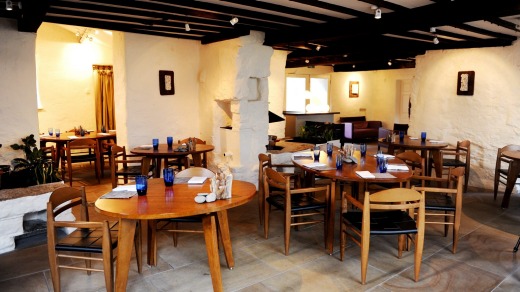
Cartmel seems to have benefited greatly from gourmet tourists making a weekend of it - the village has a definite bustle about it, and black-aproned chefs dash between the various buildings with trays of ingredients.
Simon Rogan is in Cartmel when I visit on a cool spring day. He's popped up a bit like a Jack-in-the-box, because I've just seen him in London, where his year-old fine dining restaurant, Fera at Claridges, in the beautiful old deco space formerly occupied by Gordon Ramsay, won him another Michelin star in its first few months. (L'Énclume has two.) Rogan also has two restaurants in The Midland Hotel in Manchester, Mr Cooper's House & Garden and The French.
You would think Rogan would be frazzled by the expansion of his empire (and a recent trip to Melbourne for the 2015 Food & Wine Festival) but he's rosy-cheeked and jolly. At Fera in London, I visited the kitchen to watch the chefs at work and it is the calmest kitchen I've ever been in, almost library-quiet. Much of this is due to Rogan's preference for induction cooking, which creates no hissing flames, but I suspect it's Rogan's demeanour too. Everyone just gets on with it, and there's even time during a busy lunch service for the pastry chef to make my group a special sorbet of fennel and blue cheese (tastier than it sounds.)
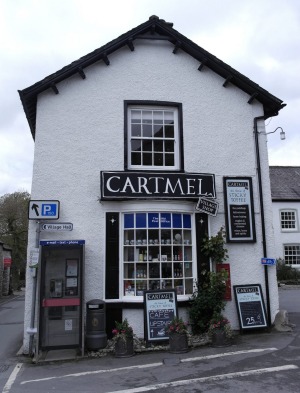
Cartmel is not only the epicentre of Rogan's experimentation with dishes, which happens in the kitchen at Aulis, sometimes in front of delighted paying guests, but the valley is also the heart of his business because it's there, on a lush 12-acre farm, that Rogan produces the exceptional ingredients for all his restaurants, in line with his pivotal philosophy that there should be a connection between cooking and growing.
Several years ago Rogan had an epiphany. L'Énclume had specialised in the sort of advanced technical cooking that was coming out of Spain, but when he had the opportunity to buy the nearby farm, he focussed on making his dishes British and regional, with an emphasis on seasonality. He would not import a single lemon. This is now his signature, although the bistro Rogan & Co does use some foreign ingredients. The farm, with its lovingly tended greenhouses, vegetable beds, nasturtium mountain and burgeoning orchard, supplies the finest of ingredients, which are the most flavourful of their kind and difficult to source elsewhere, such as baby Cherry Belle radishes, Purple Haze carrots and three kinds of rhubarb, as well as the delicate herbs and flower buds that end up in most of Rogan's visually enticing dishes. In summer, the farm produces about twenty-five large punnets of tiny mixed flowers a week.
The tiny flowers, microscopic herbs and heirloom vegetables make their way to Rogan's restaurants in Cartmel, London and Manchester, as well to the tables of other philosophically aligned UK restaurants. The dishes at Fera are scattered with so many flowers, they're like spring on a plate. The fresh produce is also used in some sensational cocktails, including a surprisingly delicious one made from cabbage and another created from distilled herbs, all picked at the farm and dispatched quickly to London.

Visitors to L'Énclume or Aulis can arrange a tour of the farm. It's a real treat. We're shown around by Rory Sheehan, a wry 25 year-old chef who trained with Sweden's Magnus Nilsson at Fäviken and who is the liaison between the restaurant and the growers. There's a constant dialogue between the kitchen and the farm - chefs' requests are written on a white board and the farm clues in the chefs on the progress of certain ingredients. An unexpected late-spring frost has killed off the courgette and cucumber plants, so menus will have to be reworked around that occurrence.
The farm doesn't supply meats and animal products or produce, such as Wye asparagus, that is already grown locally and organically ('The best in the world,' says Sheehan.) The extraordinary number of plant and herb species reflects Rogan's tastes. He's a fan of old fashioned plants like anice hyssop, elderflower, cresses and lovage. 'We're addicted to lovage,' Sheehan says.
With a box of fresh vegetables under his arm - and a roadside stop to forage wild garlic - Sheehan takes us back to Cartmel, where he dons an apron and the six of us prop on high stools at a kitchen counter. Executive Chef Mark Birchall cooks with Sheehan and restaurant manager Sam Ward is responsible for the matching wines.
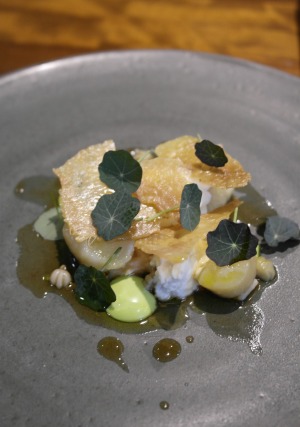
The Development Table is exactly that - we'll be treated to experimental dishes and we'll be encouraged to give our feedback, so that Rogan's crew can decide if any of them are good enough to make the menu at L'Énclume.
We start with a pretty Smoked Damson Gin and Tonic, made with prized Wye Valley damson plums soaked in gin and sugar. Perhaps unwisely, we hoe into thick slabs of sourdough bread because the apple and bacon fat butter served with it is so delicious.
The first dish is a trio of little ceramic sacks filled with shrimps from nearby Morecambe Bay, asparagus mousse, squid ink mushroom crusts and a Douglas Fir emulsion. This is followed by melting langoustine tartare with crispy pork skin, caviar, crushed hazelnut, apple gel, wood sorrel and wood sorrel flower, picked from the woods next to the farm.
The next dish, a superb raw beef sirloin, is dressed with charcoal oil, and includes mustard mayonnaise, celery crest, apple jam, celeriac, with onion ash on top, and contains wonderfully crunchy, sweet bursts of hard candy filled with gin. It's amazing.
The chefs chat while they're cooking, talking us through every step, but they work so fast that it's hard to take in every ingredient. Besides, each dish is composed of so many elements, it's mind-boggling.
Scallops from northern Scotland are hand dried and served with a caramelised cauliflower puree, steam-roasted cauliflower florets, wild strawberry jam, puffed barley and ice plant. Even a relatively simple dish, white and brown crabmeat with potatoes, crispy chicken skin, nasturtiums and goats cheese, has a story behind each ingredient.
The dessert is Conference pear poached in plum sake gel, with sweet cheese ice-cream, almond biscuit, edible carnation and a fantastic "tree cake" made with crystallised sugar from the leaves of the Rowan tree, or Mountain Ash, which is often planted in graveyards. Who knew?
Everything is cooked by induction, so there are no flames or unpleasant heat. A tranche of shoulder lamb has been cooked in balsamic vinegar for 23 hours at 63 degrees until crispy. It's this precise.
But it's far from pretentious. After seven light courses with matching wines, we stagger along a path by a brook to the kitchen of the main restaurant, L'Énclume. It's airy and casual, with no door between kitchen and dining room, so that guests are included in the production, but without the noise and heat of an open kitchen. I don't want to leave this friendly, creative place. Of course, there's always the option of returning and making a weekend of it, sleeping above the restaurant. Next time, I'll head straight for the Cartmel Village Shop and try the famous sticky toffee pudding. But I don't quite have room for it now.
www.simonrogan.co.uk
www.visitbritain.com
The L'Énclume Development Table Experience package includes two nights accommodation, dinner one night at L'Énclume and the following at Aulis, a farm tour, and breakfasts, £895 per couple from July 1 2015. On a nightly basis, standard rooms start at £119. www.lenclume.co.uk
British Airways operates daily flights from London Heathrow to Manchester. From there, it's a about a ninety minute drive north to Cartmel. www.britishairways.com